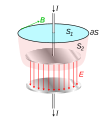Archivo:Displacement current in capacitor.svg
Apariencia

Tamaño de esta previsualización PNG del archivo SVG: 558 × 600 píxeles. Otras resoluciones: 223 × 240 píxeles · 446 × 480 píxeles · 714 × 768 píxeles · 952 × 1024 píxeles · 1905 × 2048 píxeles · 744 × 800 píxeles.
Ver la imagen en su resolución original ((Imagen SVG, nominalmente 744 × 800 pixels, tamaño de archivo: 57 kB))
Historial del archivo
Haz clic sobre una fecha y hora para ver el archivo tal como apareció en ese momento.
| Fecha y hora | Miniatura | Dimensiones | Usuario | Comentario | |
|---|---|---|---|---|---|
| actual | 14:28 20 nov 2008 |  | 744 × 800 (57 kB) | Chetvorno | == Summary == {{Information |Description={{en|Diagram of a widely used example demonstrating need for the displacement current term in Maxwell's equations.}} The diagram shows a [[Wikip |
| 04:56 11 nov 2008 |  | 744 × 800 (58 kB) | Chetvorno | {{Information |Description=Diagram demonstrating need for displacement current term in Ampere's Law. |Source=Own work by uploader |Date=2008-11-10 |Author=Chetvorno |Permission=I Chris Burks (Chetvorno) the author rel |
Usos del archivo
La siguiente página usa este archivo:
Uso global del archivo
Las wikis siguientes utilizan este archivo:
- Uso en ba.wikipedia.org
- Uso en ce.wikipedia.org
- Uso en de.wikipedia.org
- Uso en de.wikibooks.org
- Uso en en.wikipedia.org
- Uso en en.wikiversity.org
- Uso en fi.wikipedia.org
- Uso en he.wikipedia.org
- Uso en hy.wikipedia.org
- Uso en no.wikipedia.org
- Uso en ro.wikipedia.org
- Uso en ru.wikipedia.org
- Uso en tr.wikipedia.org










